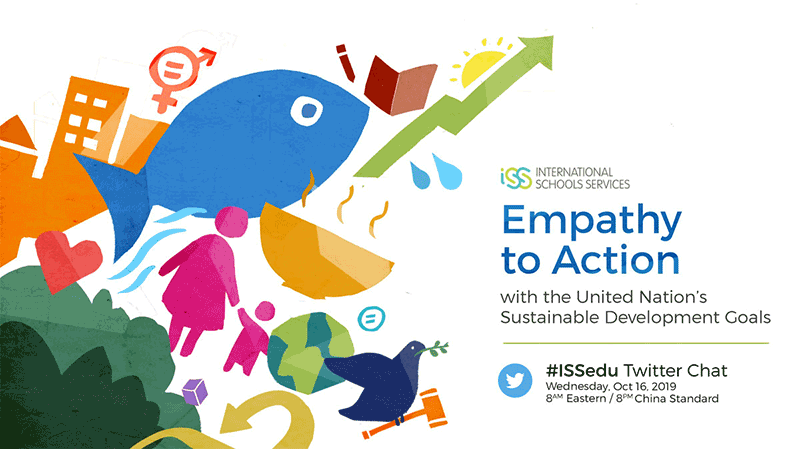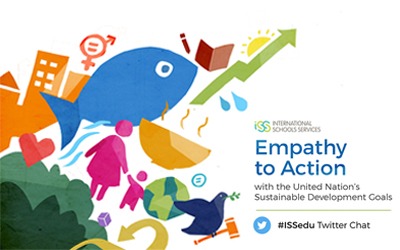#ISSedu Twitter Chat: Empathy to Action

At the October 16 #ISSedu Twitter Chat, we explored how students, educators, and schools can move from ‘Empathy to Action’ with the United Nation’s Sustainable Development Goals (SDGs). Developed in conjunction with Kevin O’Shea and Nathan Lill from Shekou International School, this chat focused on the practical and authentic ways to engage with the SDGs. Thank you to all who joined!
Learn more about the UN’s SDGs here with the SDG chat padlet. We’ve also collected a few highlights of the chat below for you to enjoy even if you couldn’t make the hour:
Q1. Why is action in regards to the SDGs important to PK12 schools?
A1: The SDGs are something we got everyone to agree on… FINALLY! They will be relevant to future careers. But, most important, KIDS CAN INNOVATE! We don't need to rely solely on adults for solutions.#isaruba #issedu #edchat #LifeOnLandMatters @makerpedia #globaled #SDGs @UN https://t.co/6RQrZ1x5ZI
— Tess Monte (@TheresaMonte) October 16, 2019
A1: It is important because we need to create awareness in our Ss of #workdissues so that we stop what we are doing wrong & start doing things right for a more #sustainableworld Also by doing this we empower Ss to share their passions, ideas and thoughts. #issedu
— AlejandraCruzMilano (@TeacherMsAle) October 16, 2019
A1: It is important that student but ALSO the teachers feel the urge to participate in making a better sustainable world. The clock is literally ticking! #issedu
— Pieter Verduijn (@pieter_verduijn) October 16, 2019
A1: We should teach the #SDGs to enable students be more aware of the situations and necessities the majority of the people have. This enables them to start thinking about solutions from an early age and develop virtuous minds such as gratitude and compassion. #ISSedu — Monica Rojas (@monicrojas6) October 16, 2019
Q2: Which SDGs are most relevant to your students, school or context? Are some more applicable than others?
A2: I think some are more 'accessible' depending on the age group. EX: Life on Land and Life Below Water is easily accessible for #earlyyears, whereas No Poverty is less so. #issedu #earlychildhood #ece #IntEarlyEd https://t.co/sOTcvigZJX
— EarlyChildhood (@ECEforLife) October 16, 2019
A2: In Physics, we explicitly discuss #SDG6 #SDG7 #SDG9 #SDG11 #SDG12 #SDG13 #SDG16 #issedu #SDGs #globalgoals
— Callie BushMiller (she/her) (@learnboldly) October 16, 2019
A2: Just this morning, we were chatting with the CEO of a local gemstone and pearl authentication organization about sustainable pearling. Being on an island, Life Below the water, Climate Action, and Responsible Consumption are all extremely important. #issedu
— Luke Meinen (@luke_meinen_) October 16, 2019
A2. #issedu We have started a schoolwide initiative this year to collect projects from all divisions. The idea is to closely monitor the activities and ensure focus areas are identified. It is coming along well.
— Shashi 🙋♂️ (@skrish2017) October 16, 2019
Q3: What are some inspiring examples of student, teacher or school run initiatives from across PK12 settings?
A3: Part 2/ My parents were avid #birders and conservationists! I had a chance to take Ss #birding and plan to start an ASA next term! My #NatureShenzhen group will also do weekend bird walks and #nature exploration! #SDGs @SDGoals #issedu @SDG2030 pic.twitter.com/P2wwBAk8Wp
— Kevin O’Shea 🇨🇦🇯🇵🇨🇳 (@MadForMaple) October 17, 2019
A3: The SDGs in Action app has a great range of relevant initiatives (and space to create your own) for PK12 settings https://t.co/CXlVwnvsVY #issedu pic.twitter.com/fzd13YauCa — john burns (@j0hnburns) October 16, 2019
#issedu Inspiring IGNITE Day at RVIS! 🌿🌿🌿🌏🌍🌎🌿🌿🌿 https://t.co/poBnYQfugF
— Laura Benson (@LBopenbook) October 16, 2019
By growing their own food students deepen their understanding of biological cycles, become more aware of food choices and value farmer's work. #issedu pic.twitter.com/6N2yEuK94d
— Monica Rojas (@monicrojas6) October 16, 2019
Our tech teacher @ShaunSchaller tried something similar last year. He took the 3D printer scraps and mistake prototypes and melted them down via his oven to form thin plastic sheets. He then used the sheets in the laser printer. #issedu pic.twitter.com/9FM8F7YOK5
— Brandon Dale (@biological_dale) October 16, 2019
Q3 At @cayintschool, there was an collaboration between HS and G2:
This week the Grade 2 Ss partnered with Mr. Bill's Environmental Science SS for a composting and gardening class. SS worked in groups to set the groundwork for our school's community garden! #issedu— Sharon Sudell (@SharonPink26) October 16, 2019
Q4: Considering SDG Goal 17 – Partnerships, what partnerships between school and communities have you fostered or could be developed?
A4: We are working on developing more community partnerships and connections. @level5bahrain has been a huge help. As someone new to a place, it can be hard to know where to start. One place – check for a website/directory for local NGOs. #issedu https://t.co/qXN2UoCJC9
— Callie BushMiller (she/her) (@learnboldly) October 16, 2019
A4: as described by my partner in crime. I myself do not work with it, but one of my colleagues is (and it is totally not his subject), but he loves working with @PactfulApp
Planning to extend the program to all secondary school for our 2nd semester here @ISAruba #issedu https://t.co/Fty0g0Siok— Pieter Verduijn (@pieter_verduijn) October 16, 2019
We’ve partnered with local NGOs on events such as beach clean ups, bottle cap collection, and organizing student-led protests. Our students also work closely with the National Trust to help with Mangrove restoration #issedu
— Brandon Dale (@biological_dale) October 16, 2019
A4: I want to reach out to #community conservation groups. Some amazing #wetlands in and around #Shenzhen. Also, I would like to make connections with local #wildlife rehab centers. I need local staff to help me make those connections! #issedu #SDG #SDGs — Kevin O’Shea 🇨🇦🇯🇵🇨🇳 (@MadForMaple) October 17, 2019
Q5: How can we measure the impact of initiatives run in our schools?
A5: 1/2 It may have to be dependent on the initiative being run. Documentation is a great way to start. Recording everything that is done will provide ways to pull out statistics to determine impact at a later date. #issedu
— Luke Meinen (@luke_meinen_) October 16, 2019
A5: There are quantitative data sets and qualitative. Sometimes the qualitative can be more important because mindset changes are involved and that's what leads to long lasting solutions. #issedu #SDGs
— Callie BushMiller (she/her) (@learnboldly) October 16, 2019
A5 Impact can be measured in multiple ways. For recycling > volume of product. For outreach > # partners engaged. For health/wellbeing > group fitness apps. Lots of authentic measures #issedu
— john burns (@j0hnburns) October 16, 2019
I think documenting with photos and book making or school publications are a good way to measure impact of initiatives and programs.Also making sure programs and initiatives are continued throughout the years #issedu
— AlejandraCruzMilano (@TeacherMsAle) October 16, 2019
Q6: How can we inspire students without burdening them with the weight of potential issues in regards to the SDGs?
A6: Break down the big issues into smaller, more accessible pieces. And always include an inspirational quote. 🙂 #issedu #SDGs pic.twitter.com/2wx7zDX7Zm
— Callie BushMiller (she/her) (@learnboldly) October 16, 2019
A6: start with the smaller things they can start solving right away. We cannot expect from our children to be the next Gretha Thurnberg or Boyan Slat. Start to solve the problems in their direct neighborhood. #issedu
— Pieter Verduijn (@pieter_verduijn) October 16, 2019
A6 Focusing on the positive impact of their initiatives rather than the detrimental effect of not taking action #issedu. #SDGs
— john burns (@j0hnburns) October 16, 2019
A6: When teaching learners about #SDGs we shouldn't focus on doom and gloom. ESPECIALLY with younger learners. We should focus on celebrating the world and loving it. I'm big into #SDG 15. I teach young ones to LOVE #nature. In time with love they will protect it! #issedu
— Kevin O’Shea 🇨🇦🇯🇵🇨🇳 (@MadForMaple) October 17, 2019
Q7: How can #ISSedu schools more effectively connect and share their engagement with the SDGs?
A7: We are doing it right now!
Also, connect with the great work @inspirecitizen1 and @inspirecitizen2 are doing in schools around the globe. #issedu https://t.co/SlvbrkXRao— EarlyChildhood (@ECEforLife) October 16, 2019
A7: I love the idea of a podcast. I started using with my kids in class. They love them!#isaruba #issedu #edchat #LifeOnLandMatters #SDGs @UN @makerpedia #globaled https://t.co/WrRPUMyElk
— Tess Monte (@TheresaMonte) October 16, 2019
Within #issedu schools it would be cool to look at a mini series or podcast created by students across school groups on building awareness and showcasing what their schools are doing about each of the #SDGs. Could be shared to a wider group as well.
— Luke Meinen (@luke_meinen_) October 16, 2019
Q8: Who should we follow, or what resources should we connect with in terms of learning more about practical application of the SDGs?
A8: @Designathons hosts a Global Designathon relating to #SDGs every year. This will be the second year that Aruba is participating. Check to see how you can host one in your city!#isaruba #issedu #edchat #LifeOnLandMatters @UN @makerpedia #globaled https://t.co/3Rv64gQiS1
— Tess Monte (@TheresaMonte) October 16, 2019
A8: Compass Education offers training in systems thinking and sustainability. Insightful and impactful learning opportunities. https://t.co/GI1CJkG5U3 #issedu #SDGs #GlobalGoals
— Callie BushMiller (she/her) (@learnboldly) October 16, 2019
A8 – Def follow @GlobalGoalsUN! #issedu
— john burns (@j0hnburns) October 16, 2019
A8: #earlyyears #educators, stay tuned as the EY SDG website is being developed. https://t.co/5bDuPrV8a6
— EarlyChildhood (@ECEforLife) October 16, 2019

